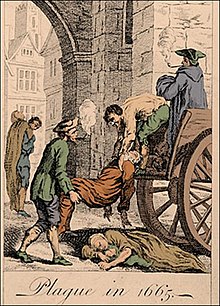A Journal of the Plague Year
LC Class PR3404 .J6 | | |
| Text | A Journal of the Plague Year at Wikisource | |
|---|---|---|
A Journal of the Plague Year: Being Observations or Memorials, Of the most Remarkable Occurrences, As well Publick as Private, which happened in London During the last Great Visitation In 1665, commonly called A Journal of the Plague Year, is a book by Daniel Defoe, first published in March 1722. It is an account of one man's experiences of the year 1665, in which the bubonic plague struck the city of London in what became known as the Great Plague of London, the last epidemic of plague in that city. The book is told somewhat chronologically, though without sections or chapter headings, and with frequent digressions and repetitions.[1]
Presented as an eyewitness account of the events at the time, it was written in the years just prior to the book's first publication in March 1722. Defoe was only five years old in 1665 when the Great Plague took place, and the book itself was published under the initials H. F. and is probably based on the journals of Defoe's uncle, Henry Foe, who, like 'H. F.', was a saddler who lived in the Whitechapel district of East London.
In the book, Defoe goes to great pains to achieve an effect of verisimilitude, identifying specific neighbourhoods, streets, and even houses in which events took place. Additionally, it provides tables of casualty figures and discusses the credibility of various accounts and anecdotes received by the narrator.
The book is often compared to the actual, contemporary accounts of the plague in the diary of Samuel Pepys. Defoe's account, which appears to include much research, is far more systematic and detailed than Pepys's first-person account.

Classification
How the Journal is to be classified has been disputed.
Other literary critics have argued that the work should be regarded as a work of imaginative fiction, and thus can justifiably be described as an "historical novel".
Scott's somewhat ambiguous view of the nature of the Journal was shared by Defoe's first major biographer, Walter Wilson, who wrote in Memoir of the Life and Times of Daniel De Foe (1830) about it that "[Defoe] has contrived to mix up so much that is authentic with the fabrications of his own brain, that it is impossible to distinguish one from the other; and he has given the whole such a likeness to the dreadful original, as to confound the sceptic, and encircle him in his enchantments." In Wilson's view the work is an "alliance between history and fiction" in which one continually morphs into the other and back again. This view is shared by John Richetti who calls the Journal a type of "pseudohistory", a "thickly factual, even grossly truthful book" in which "the imagination ... flares up occasionally and dominates those facts."[4]
These alternative conceptualisations of the Journal – as fiction, history, or history-cum-fiction – continue[needs update] to exist.[4]
Adaptations

- In 1945, the syndicated radio programme The Weird Circle adapted the novel into a condensed 30-minute drama.
- The 1979 Mexican film El Año de la Peste (The Year of the Plague), directed by Mexican director Felipe Cazals from a screenplay written by Gabriel García Márquez, was based on A Journal of the Plague Year.
- The Oscar-nominated 1999 German stop motion animated short film Periwig Maker is based on A Journal of the Plague Year.[7]
- A 2016 BBC Radio 4 play adapted the novel into a 60-minute drama.[8]
A Journal of the Plague Year also served as the initial inspiration for Anthony Clarvoe's play The Living.
In popular culture
References to the book's title have been made in
A comparison of plague-driven behaviour described by Defoe and the COVID-19 crisis of 2020 is discussed in "Persistent Patterns of Behavior: Two Infectious Disease Outbreaks 350 Years Apart", an article in the journal Economic Inquiry, and also in a commentary in The Guardian.[10][11]
References
- PMC 3314902.
- JSTOR 1345591., p. 311.
- ^ .
- ^ JSTOR 2873233.
- ^ Nicholson, Watson (1919). The Historical Sources of Defoe's Journal of the Plague Year, Boston: The Stratford Co., pp. 97, 100.
- JSTOR 460900.
- ^ Lichtenstein, Jesse "Bringing Out the Dead" The New Republic
- ^ "A Journal of the Plague Year" BBC Radio 4 website
- ^ Agranoff, David (6 February 2019) "Book Review: Journals of the Plague Years by Norman Spinrad " Postcards From a Dying World
- ISSN 1465-7295.
- ^ Dasgupta, Utteeyo (20 December 2020). "Research explains how people act in pandemics – selfishly, but often with surprising altruism". The Guardian. Retrieved 13 January 2021.
Further reading
- Lau, Travis Chi Wing (Summer 2016), "Defoe Before Immunity: A Prophylactic Journal of the Plague Year", Digital Defoe: Studies in Defoe & His Contemporaries, 8 (1): 23–39, ISSN 1948-1802, retrieved 3 September 2021
- Seager, Nicholas (2008), "Lies, Damned Lies, and Statistics: Epistemology and Fiction in Defoe's 'A Journal of the Plague Year'", The Modern Language Review, 103 (3): 639–653, S2CID 246643865
External links
 The full text of A Journal of the Plague Year at Wikisource
The full text of A Journal of the Plague Year at Wikisource- Etext with facsimile page images: Defoe, Daniel. A Journal of the Plague Year. Printed for E. Nutt at the Royal-Exchange; J. Roberts in Warwick-Lane; A. Dodd without Temple Bar; and J. Graves in St. James's-Street, 1722. Literature in Context: An Open Anthology.
- A Journal of the Plague Year at Standard Ebooks
- A Journal of the Plague Year at Project Gutenberg
 A Journal of the Plague Year public domain audiobook at LibriVox
A Journal of the Plague Year public domain audiobook at LibriVox- Dermot Kavanagh's article on the London Fictions site about the London of 'A Journal of the Plague Year'

